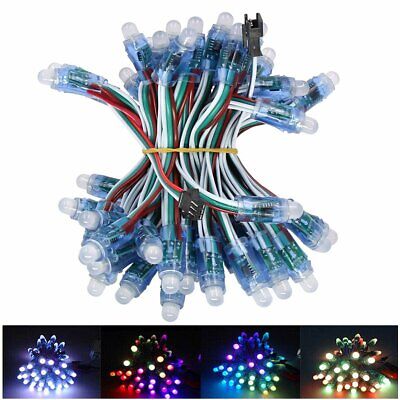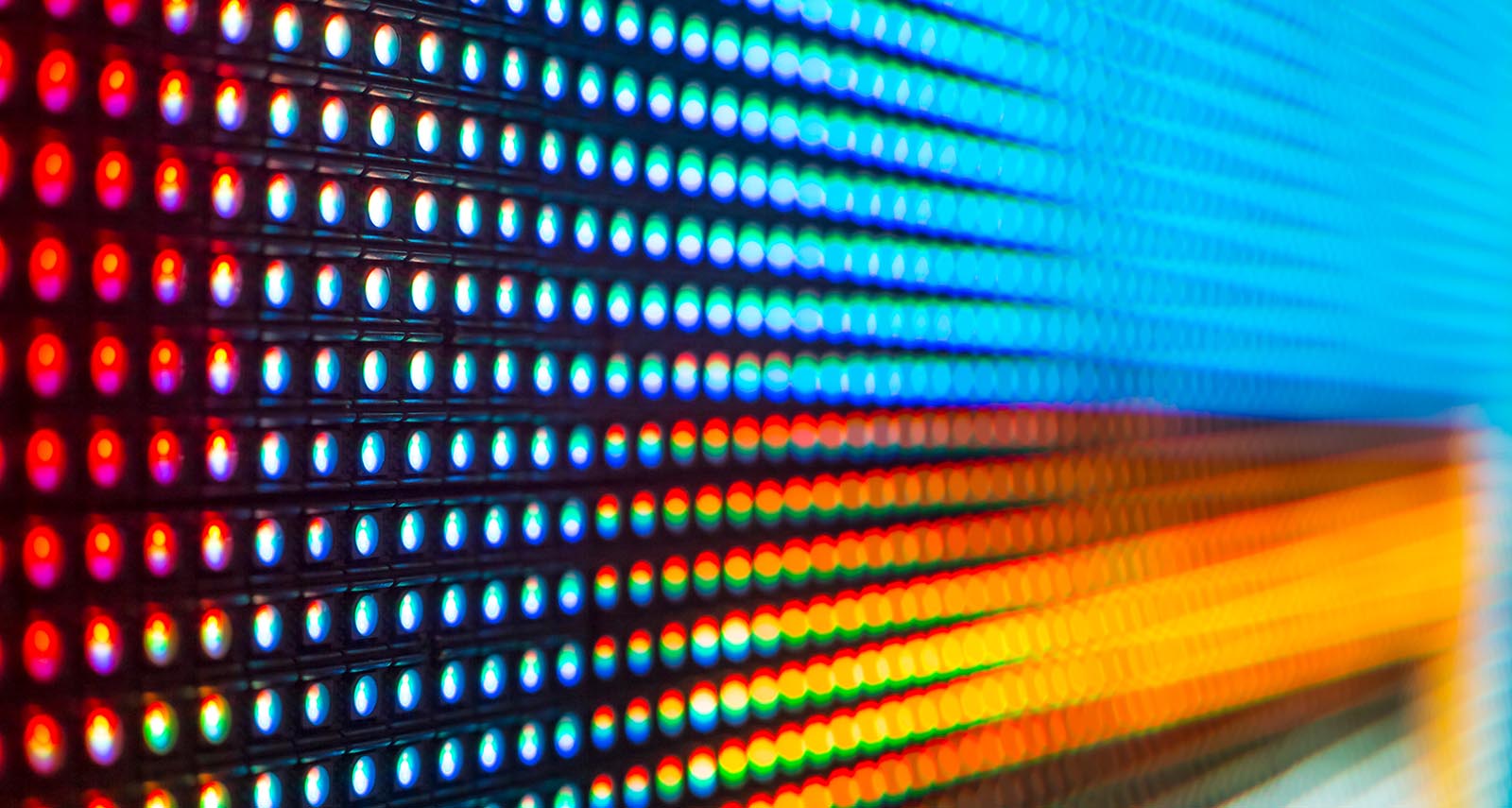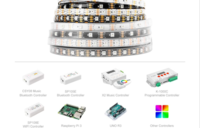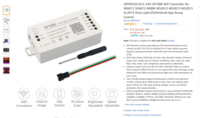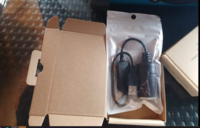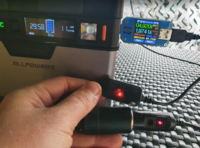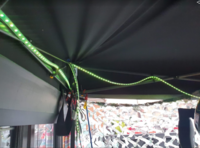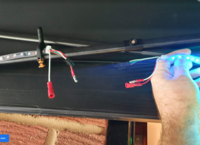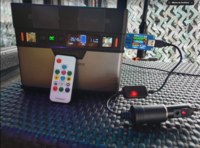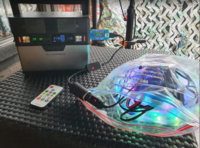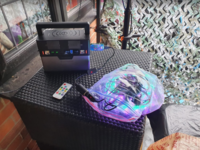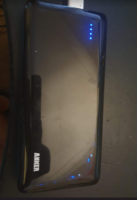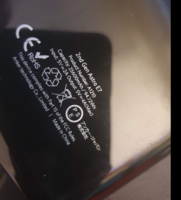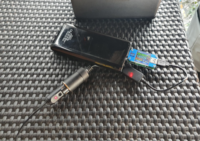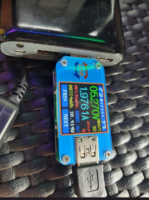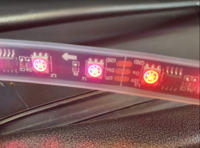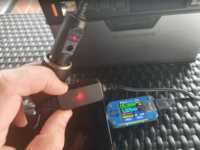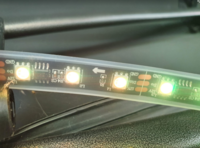@Dellmassive is there any reason you have never gone for the newer ws2815 LED strips? Is it just power consumption?
yes, the ws2815 LED strips are relatively new tech.
and the 5v stuff needs high current USB 5v drivers . . . . . 12v is more efficient.
and most of the kit I've shown above i already have, own, use.
so ill be looking at ws2812b ws2813 ws2815 in due course . . . . . . . . buying all this stuff to test and play with is expensive !!!
anyway the evolution is . .
RGB 12v: controller chip is on a master box that drives the RGB lines on a whole strip
ws2811 12v 3wire : controller chip is the string its self and drives 1 or 3 leds as a pixel
ws2812/b 5v 4wire : controller chip is integrated into the LED itself, 1x LED per pixel
ws2813 5v 4wire : controller chip is integrated into the LED itself, 1x LED per pixel
ws2815 12v 4wire : controller chip is integrated into the LED itself, 1x LED per pixel
so reading the below the next setup is to the the ws2815 12v controllers and strips . . . . . . .
******************************************
quotes: . . . . . . . . . . . . . . . .
As near as we can tell, the popular WS2812 individually addressable RGB LED was released to the world sometime around the last half of 2013. This wasn’t long ago, or maybe it was an eternity; the ESP8266, the WiFi microcontroller we all know and love was only released a year or so later. If you call these things “Neopixels”, there’s a good reason:
Adafruit introduced the WS28212 to the maker community, with no small effort expended on software support, and branding.
The WS2812 is produced by WorldSemi, who made a name for themselves earlier with LED driver solutions, especially the WS2811, an SOIC chip that would turn a common anode RGB LED into one that’s serially controllable. When they stuffed the brains from the WS2811 into a small package with a few LEDs, they created what is probably the most common programmable LED lighting solution available today.
A lot has changed in the six years that the WS2812 has been on the market. The computer modding scene hasn’t heard the words ‘cold cathode’ in years. Christmas lights are much cooler, and anyone who wants to add blinky to their bling has an easy way to do that.
But in the years since the WS2812 came on the market, there are a lot of follow-up products that do the same thing better. You now have serially addressable LEDs that won’t bring down the rest of the string when they fail. You have RGBW LEDs. There are LEDs with a wider color gamut and more. This is a look at the current state of serially addressable RGB LEDs, and what the future might have in store.
WS2813
The WS2812 and WS2812B LED has four pins: power, ground, data in, and data out. The idea is to feed a string of these LEDs some power, send data in, and the LEDs will light up. The WS2812 and WS2812B are nearly identical, with the ~B version having reverse current protection, just in case you forget red is positive and black is negative. It’s pretty simple for a 4-pin device.
One downside of the WS2812 is that when they’re wired in serial, if one goes down, the rest of the string goes down. Sure, the failure rate might only be a quarter of one percent in the worst case, but we’ve seen strings with hundreds of WS2812s hanging off of it. This sort of reliability is not something you want when you’re dealing with hundreds or thousands of a thing.

The WS2813 is the solution to one LED bringing down the rest of the string. There are six pins in this package, and two data signals. There are integrated caps for simplifying the layout, and the refresh frequency can reach up to 2 kHz. Basically, if you’re doing something with WS2812s, do it with WS2813s instead. This is especially true if you’re putting these RGB LEDs through a reflow oven, just trust me on this.
YOU WANTED SMALLER LEDS?
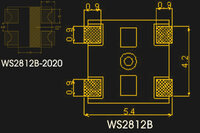
While the WS2812B, 2813, and associated LEDs are great for adding blinky, there’s only so much you can do with a large, 5 mm x 5 mm square package. For some applications, pixel pitch is important, and if you’ve ever seen a high density LED matrix made with small LEDs, you’ll know what I’m talking about. Just look at the screen that’s displaying this text.
What if there were an individaully addressable RGB LED that were smaller? That’s where the WS2812B-2020 comes in. Instead of 5 mm square, it’s 2 mm square. How big of a difference does that make? Check out the graphic to the right. That’s the footprint for a regular 2812B and a 2020-sized version, scaled to the correct relative dimensions. You can fit four of them in the footprint of a WS2182.
WS2815
While the WS2812 plays well with five volts, ohm’s law is a thing and RGB LEDs draw a lot of current. It would be nice if there were an individually addressable RGB LED that worked with higher voltages. It’s like how electric kettles aren’t a thing with 120 V mains power. Sometimes more voltage is better.
Enter the WS2815. Running at 12 V decreases the current, decreases resistive losses, and if you’re running really long strands of LEDs, makes mixing LED colors more consistent.
APA-109B
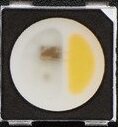
The APA-109B. The ‘B’ stands for ‘white’.
As much as we enjoy shouting “
WorldSemi” as often and as loudly as possible, there are other manufacturers of serially addressable LEDs, and some of these chips have some interesting features.
I’d like to tell you a story about why engineers and marketers should never mix. A few years ago, an engineer at Sharp was reading the relevant literature on wide color gamut displays and discovered a vast amount of research into producing more vivid colors. The literature said there was a deficiency in traditional RGB color spaces, and the human eye is incredibly sensitive to green. If you want to create a display with a wide color gamut, you need to make a display with four colors: red, green, blue, and what’s best described as ’emerald’. The emerald is deeper, and not as ‘neon’ as a traditional green sub-pixel on an LCD TV.
An executive at Sharp ran with the idea until a marketer stepped in and said that nobody can sell two greens. What would you call it, “other green”. The engineer went back to the drawing board, crossed out ’emerald’, and wrote in ‘yellow’. This was
Sharp’s Quattron technology, found in their Aquos line of TVs, and yes, each pixel had four subpixels: red, green, blue, and yellow.
There were ads starring the captain of the Excelsior. Yes, there was a television ad (that you would watch on a TV) showing off the capabilities of a television with a wider color gamut enabled by a fourth primary color in the display. It’s around this time that your mind undergoes liquefaction under the intense pressure of attempting to comprehend reality. Don’t worry, the feeling won’t pass, but you do get used to it.
The APA-109B is the solution to trying to display white with red, green, and blue LEDs. If you’ve ever tried to put white on a panel of WS2812s, you’ll notice it isn’t
quite right. It’s an electric Monet, with visible pastels swirling about, or at least that’s what it looks like when you’re staring into five hundred watts of RGB LEDs. The APA-109B adds a fourth LED in a 5 mm package, in this case a white LED. It takes up literally half the package, but if you need a white serially addressable LED, this is the one you go for.
******************************************
The core of the library is providing support to a number of LED chipsets that are out there.
SPI Chipsets
(See the [chipset reference] wiki page for a more complete list with more information on each chip)
SPI based chipsets are usually 4 wires - data, clock, power, and ground. The advantage to these led chipsets is they can be cheap, the SPI data protocol does well over distance, and with some chipsets, you can get really high data transfer rates.
- LPD8806 - a workhorse of an SPI based chipset, allows for high speed writing of data (we've pushed over 20Mbps to these chips!).
- WS2801 - a lower speed SPI based chipset, data rate is limited to 1Mbps, but they're cheap
- SM16716 - another SPI based chipset, somewhat strange protocol.
- Total Control Lighting - Also known as P9813, this is an SPI chipset that is starting to see more use. (Support for this library has been written, just needs testing, now!)
- APA102 - another SPI based chipset, looks promising, packaging similar to the WS2812, but potentially much higher data rates (w/FastLED2.1)
3-Wire Chipsets
Three wire led pixels are becoming quite popular. Having only data, ground, and power lines, they're a bit more compact than the SPI based chipsets (even further, the WS2812B's combine the led controller chip and the led in a single package!).
- Neopixel - Aka the WS2811 (or WS2812, or WS2812B), these seem to be the rgb leds of choice for many people right now.
- TM1809/TM1804 - A common chipset for a while on aliexpress, has a similar protocol to the WS2811 and friends.
- TM1803 - Sold by radio shack
- UCS1903/UCS1903B/UCS1904/UCS2903 - Another 3 wire chipset, slower data protocol than the others, which were already slow. Not terribly common.
- GW6205 (w/FastLED2.1)
- LPD1886 - a 3 wire chipset that is 12-bits per pixel instead of the usually 7/8-bit per pixel most of the other chipsets seen are so far (w/FastLED2.1)
Not yet supported
Of course, progress always marches forward, and there's a variety of new led chipsets on the horizon for the library to support. Here's a taste of what's coming:
- AS1130
- TLC5940
- TM1829 - a 3 wire chipset that also allows dynamically changing the base line power usage!
- TM1812
- D3001/CY3001 - investigating this chipset.
Deprecated chipsets
The older version of this library, FastSPI_LED, supported a number of chipsets that required work on the host MCU to manage PWM. For a combination of reasons, including these chipsets going away, as well as a desire to get away from having the library rely on timer based code, those chipsets are no longer supported:
- *595 shift register chips
- HL1606 - spi based for on and off, PWM was managed on the host
- LPD6803 - spi based, did PWM on chip, but required host MCU to strobe clock line to drive PWM
****************************************************
The FastLED library for colored LED animation on Arduino. Please direct questions/requests for help to the FastLED Reddit community: http://fastled.io/r We'd like to use github "issues&...

github.com
As near as we can tell, the popular WS2812 individually addressable RGB LED was released to the world sometime around the last half of 2013. This wasn’t long ago, or maybe it was an eternity;…

hackaday.com
